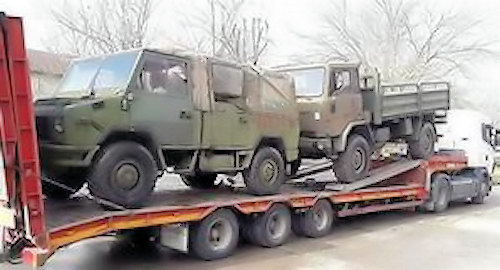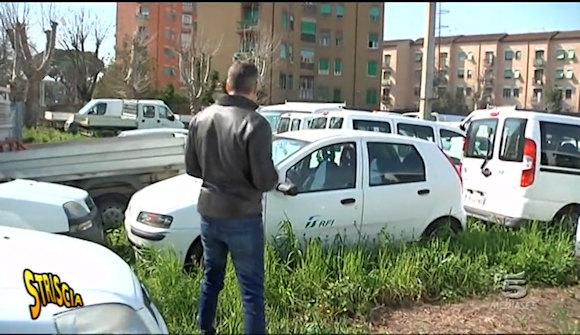The vehicles used by the Armed Forces, in addition to those assigned to aid agencies, Regions, municipalities and the public administration, represent an important investment by the community for the functioning of the country. This is an important basin of over 30.000 units (public function census 2017-2018) to which is added the military vehicle fleet which generally receives much more attention than the sectors mentioned above. This is perhaps due to the old school inherited from some marshal at the head of vehicle sections.
However, there is an embarrassing gap between the real needs for public employment and what is bureaucratically deliberated for the purchase. A vehicle assigned to the public administration is unlikely to follow a mileage related to its registration, but we regret to note that cases of unused vehicles.
Will this inactivity do well?
In addition to purchases, there are realities that, for various reasons, receive vehicles as donations, for example the Municipalities or the Italian Red Cross, but when it comes to heavy vehicles, the control of the situation often escapes from the hands of those who (through no fault of their own) do not is a specialist in the sector. In fact, it is not difficult to observe sunny squares where vehicles are parked for months or even years.
Inactivity of heavy vehicles
If we exclude vehicle stops for alienation interests, there are administrations that prefer to stop a vehicle indefinitely rather than find a role for it, perhaps even profitable. Surely one of the reasons lies in the handling costs and the real need to own certain types of vehicles (so why were they bought?), But also from the mechanisms of the bureaucracy (some examples come from the Civil Protection).
 In other cases the vehicles remain stationary waiting to be sorted in the institutions, but the "long waits" are certainly not good.
In other cases the vehicles remain stationary waiting to be sorted in the institutions, but the "long waits" are certainly not good.
Cobwebs between fenders and dry tires, or rusty brake discs are what catches the eye when you are on a parking area.
A reality that makes a possible return to service very unlikely.
Some time ago I asked a private body if I could move some trucks that had been stopped for some time for about ten kilometers, but the elusive reply from the interlocutor did not seem to show interest in my availability, perhaps even for fuel costs. The fact is that the sudden breaks were not lacking right in the middle of an intersection.
The concept of full lease for cost containment, but I believe it is also a fallback following the cancellation of the car parks associated with the ministries' workshops.
The alternatives for functional optimization are also the reliance on external companies or, as has been the case for years in the Bundeswehr, the rental, if necessary, of vehicles and trained personnel.
When heavy vehicles are abandoned for a long time they do not suffer from symptoms very different from cars and therefore, they should receive a small movement of a few kilometers at least two or three times a month, but this does not always happen.
Basically, heavy vehicles work under hydraulic and pneumatic pressures, an aspect that suggests the high number of seals already present on a simple truck.
The inactivity and the heat of the sun are among the elements that cause the deterioration of the seals that lose their quality and become much more prone to leaks. An air leak on a heavy vehicle has, just to get an idea, the consequence of blocking the vehicle suddenly, perhaps at an intersection.
 Then there is the electrical aspect, such as batteries that lose charge and the ability to store it, and cables and wiring that become more subject to dispersion.
Then there is the electrical aspect, such as batteries that lose charge and the ability to store it, and cables and wiring that become more subject to dispersion.
In terms of supply and mechanics, it is the injectors that become encrusted and, in the case of modern control systems Common Rail, I leave it to you to imagine the consequences ...
Power steering, brake cylinders and service belts are other sensitive elements when the vehicle is stopped. Then there are the tires that dry out and harden resulting in real slicks already after a year of inactivity (ovalized) in the wet, as well as losing the tread pattern along the way.
Instead, what remains intact is the crankcase, cylinders and pistons, as evidenced by the folkloristic video testimonies of the mechanics who, after fifty years, made Fiat 642N engines roar again. It is essential to immediately change the oil (decanted in the sump) of the engine, gearbox and differential. Repairs for the rearrangement after a long inactivity and to pass the overhaul are very expensive and often, with current budgets, the scrapping of the poor, forgotten vehicle is cheaper.
Due to its simplicity, the military ACM80 / 90 from Iveco represents one of the undisputed jewels of structural longevity and components that still give a hard time to much more sophisticated vehicles in its category.
Once again the military is teaching
I often happened to turn to different army barracks and my gaze, escaping the formal context, escaped right there, on the car squad. The ACM80s (I remember a regiment at the NRDC-ITA) were neatly parked and covered, probably ready for discontinuation, but still fully functional. The more recent ones were instead maintained with almost maniacal care.
 A QS chief sergeant explained to me that this is actually the army standard albeit with some differences from one barracks to another. He also told me that the mileage upgrade: in this case not to train the driver, but for the conservation of the vehicle if not used.
A QS chief sergeant explained to me that this is actually the army standard albeit with some differences from one barracks to another. He also told me that the mileage upgrade: in this case not to train the driver, but for the conservation of the vehicle if not used.
He did not want to enter the controversial context of some vehicle or material but I believe that a reference to the AR90, the most used, was perceptible. However, some ACM90 still makes its roar heard in the barracks as a vehicle used for driving school and beyond.
By virtue of this, participating in tenders for the purchase of a former military vehicle with a few kilometers is almost always a good idea.
In short, let's not be surprised, but let's rejoice when politics remembers that the military sector is synonymous with efficiency and capability, qualities that should also be emulated in many rooms of the public administration.
Photo: Mediaset / author / web












